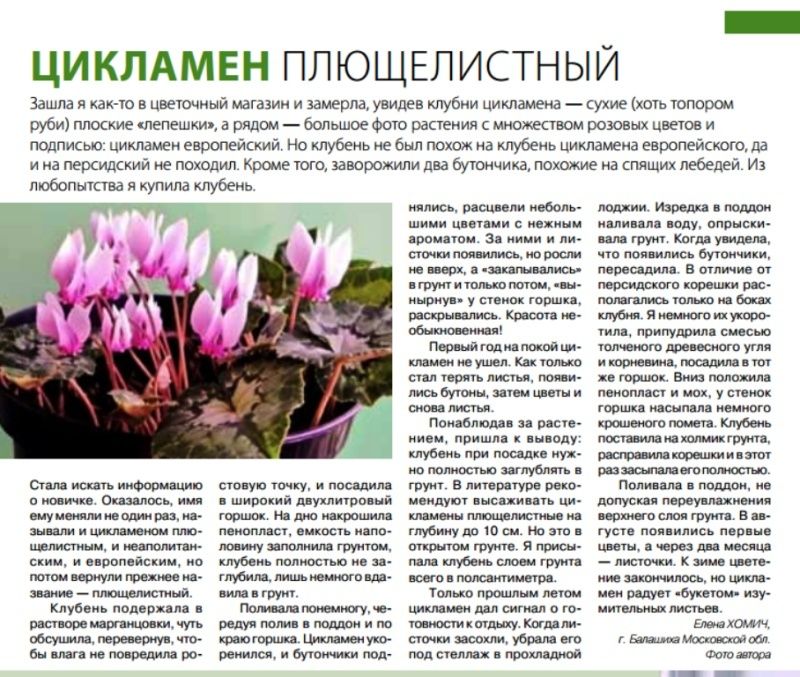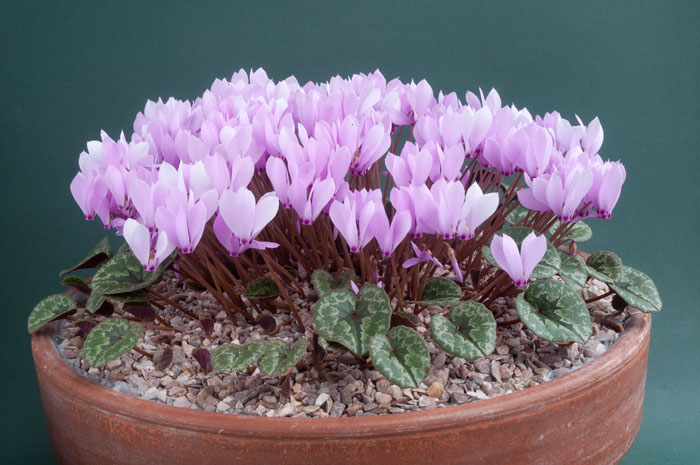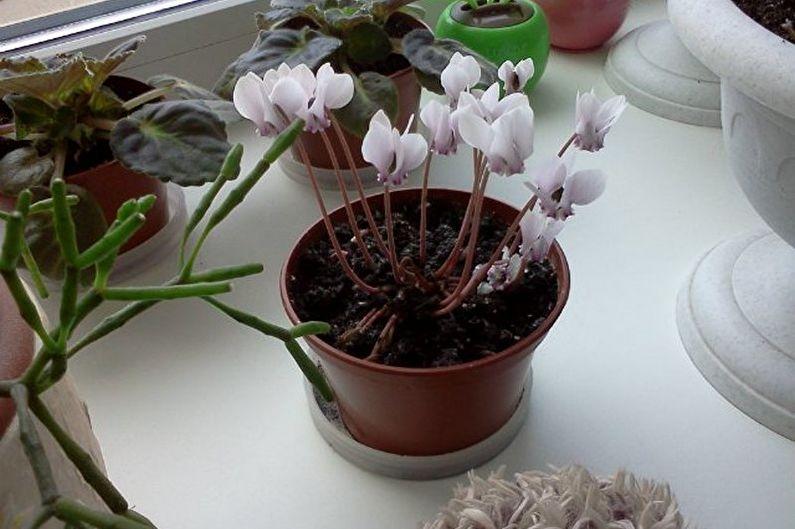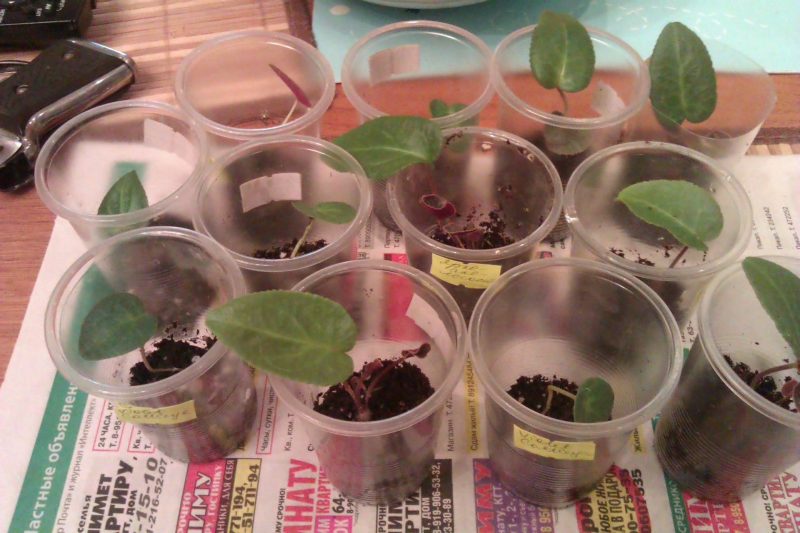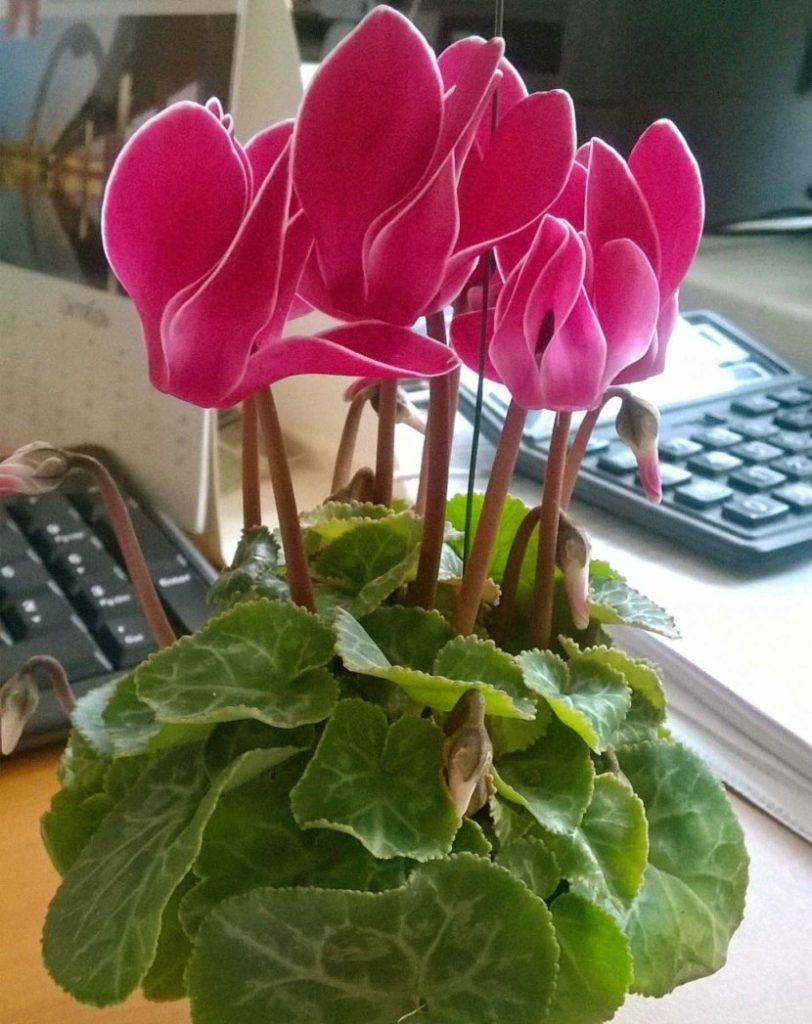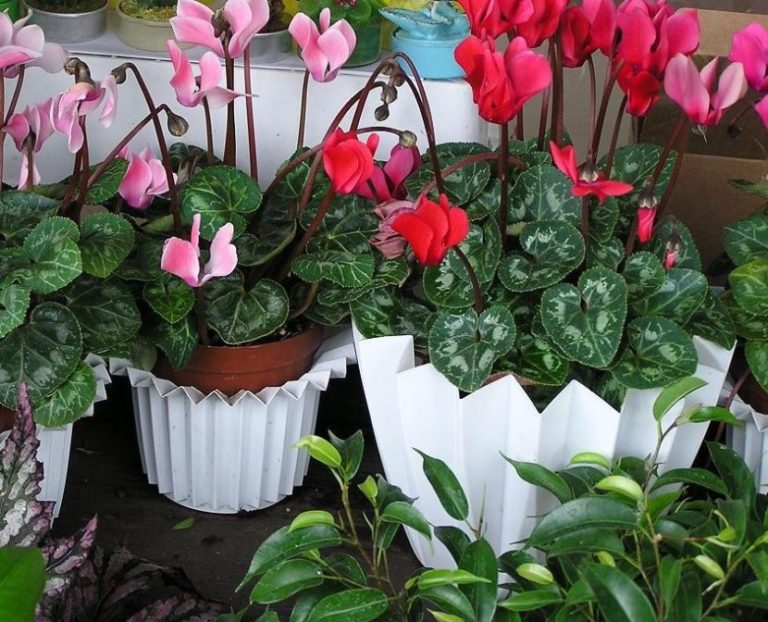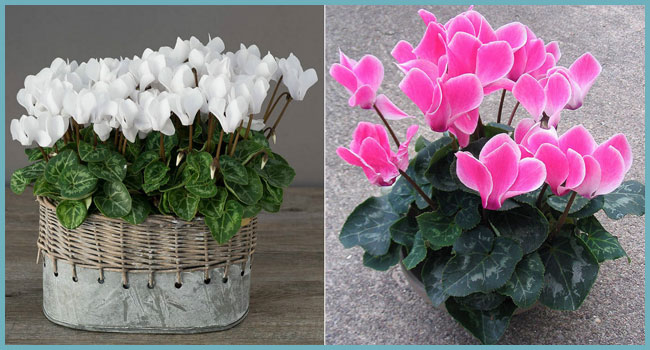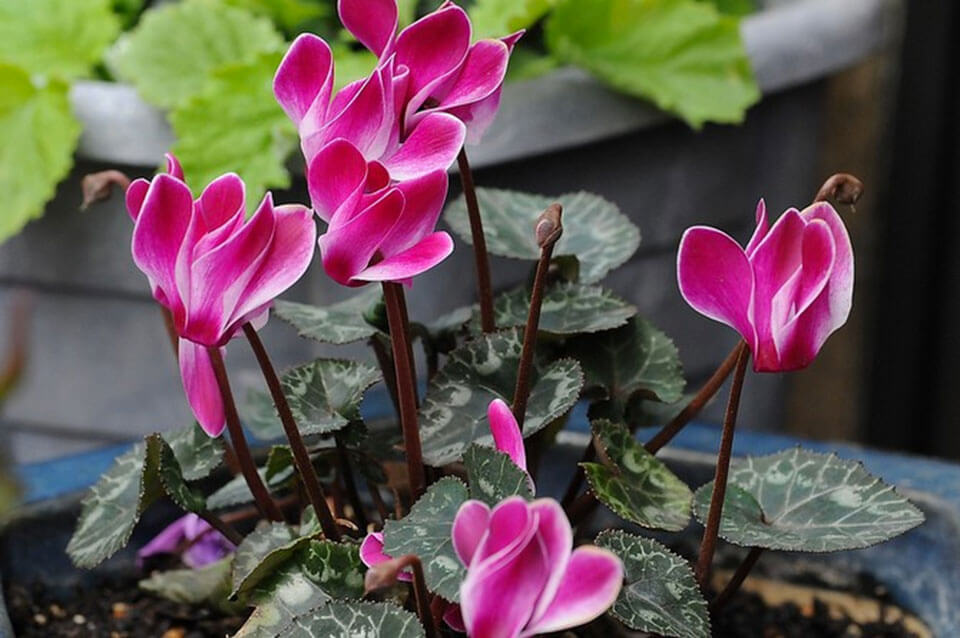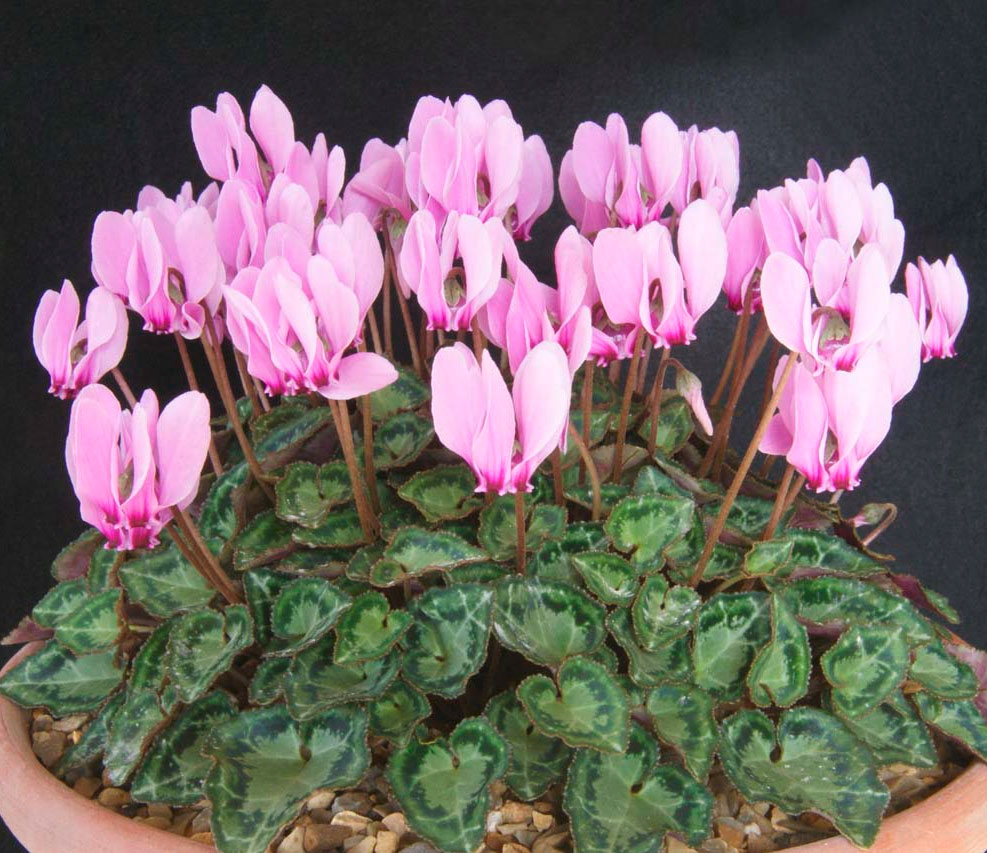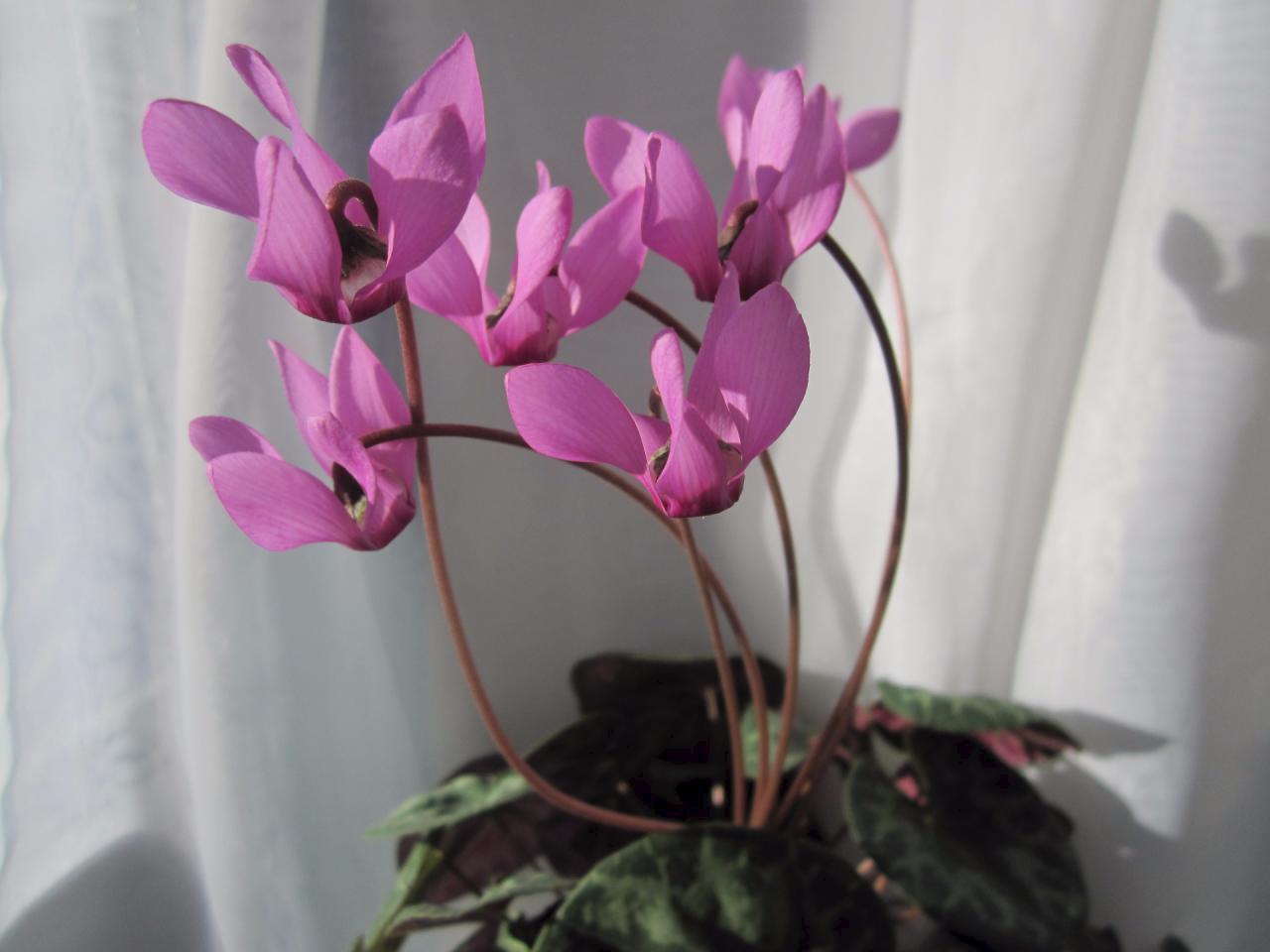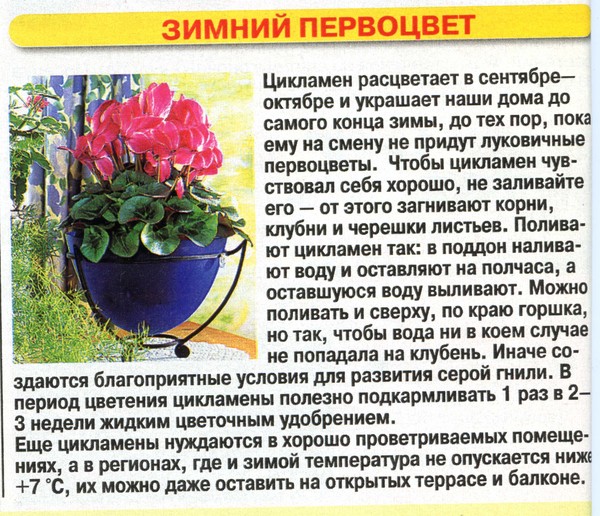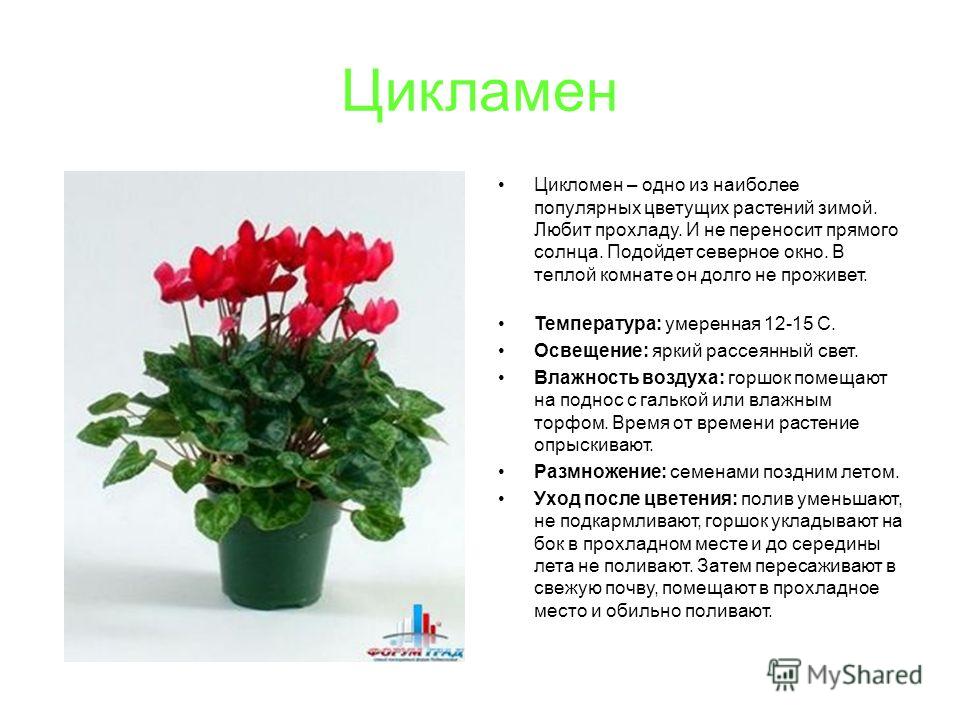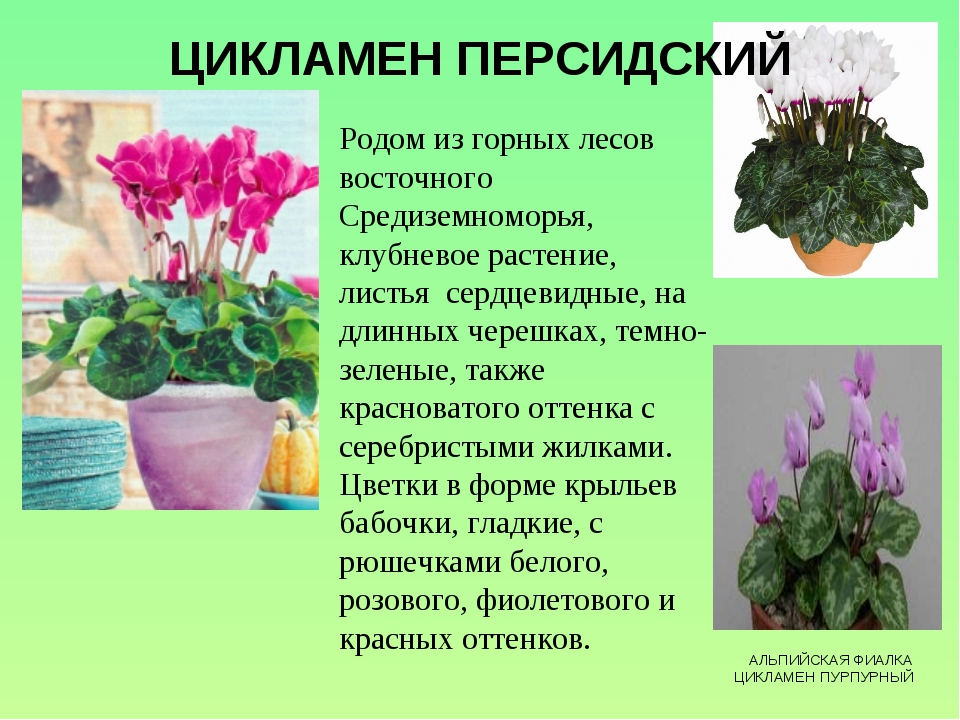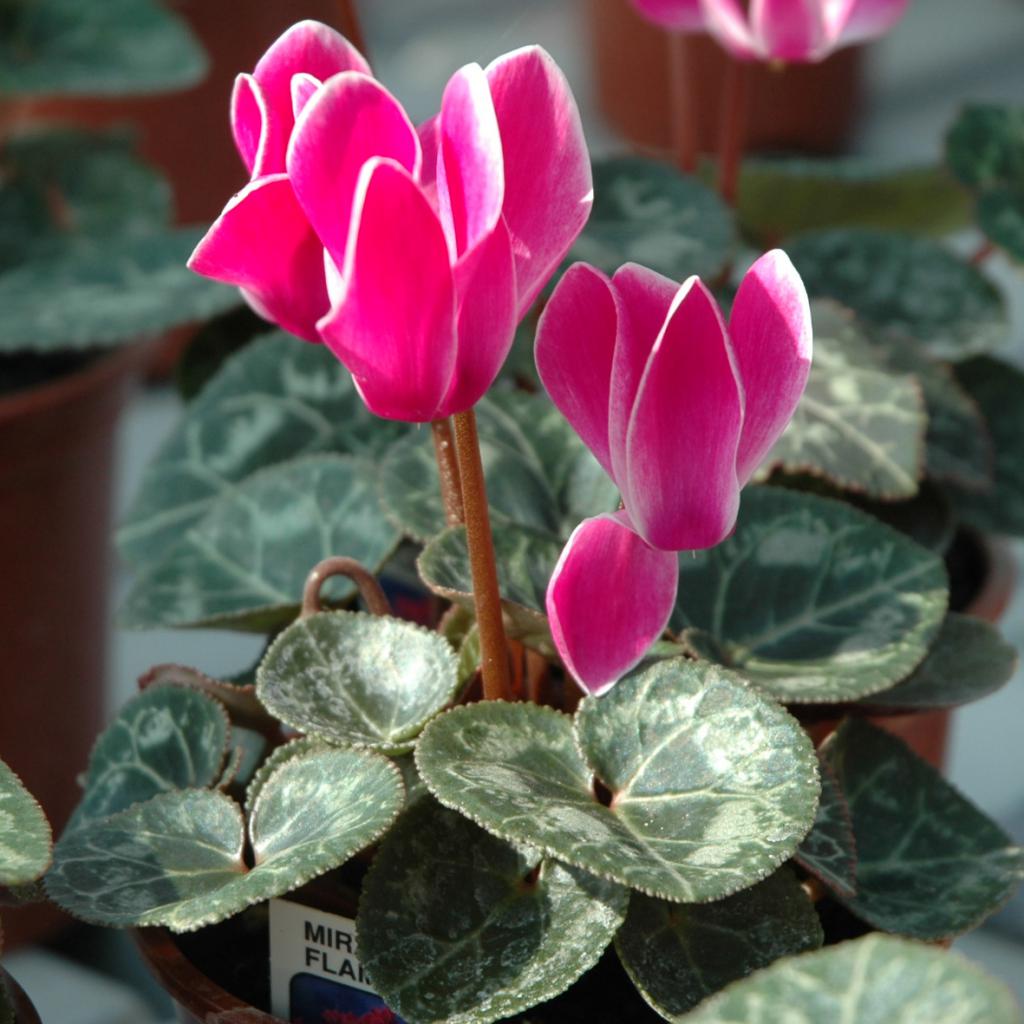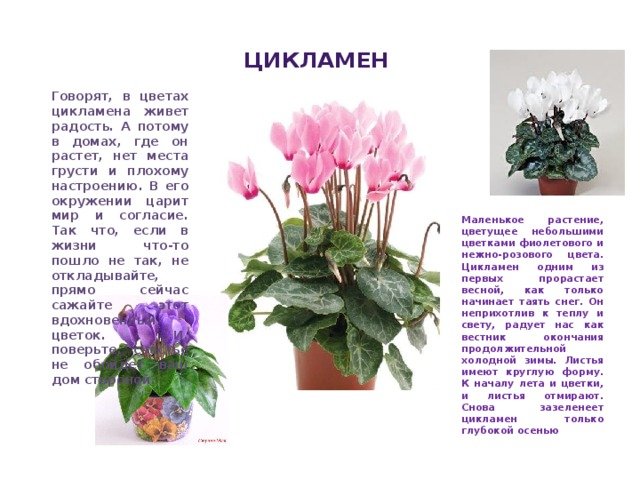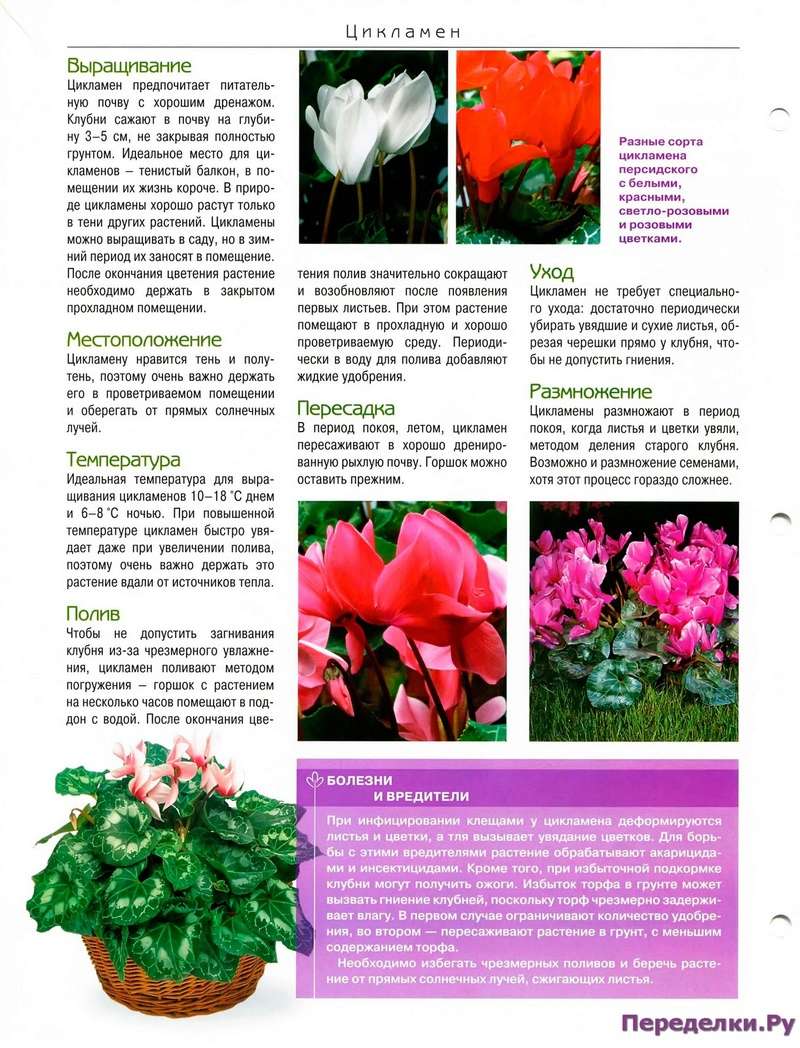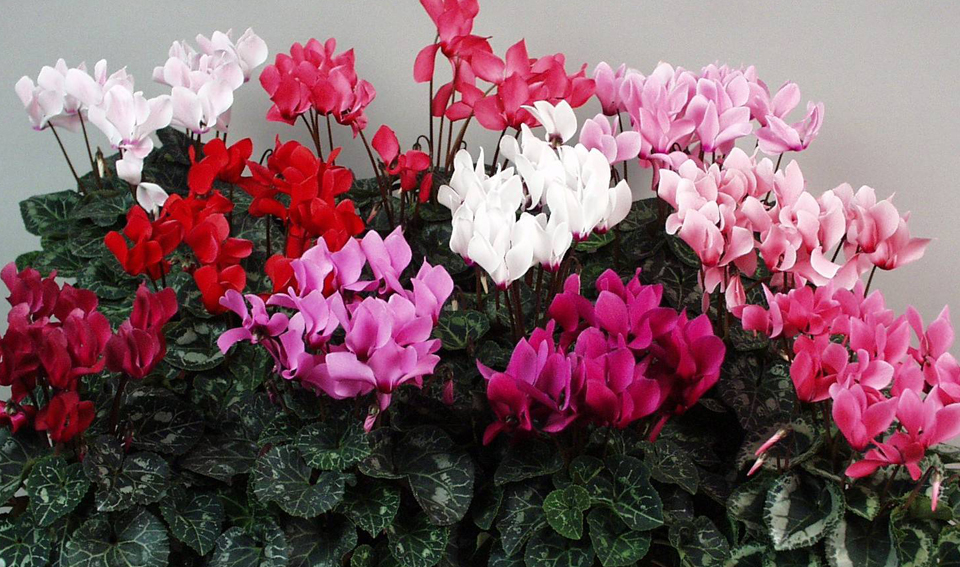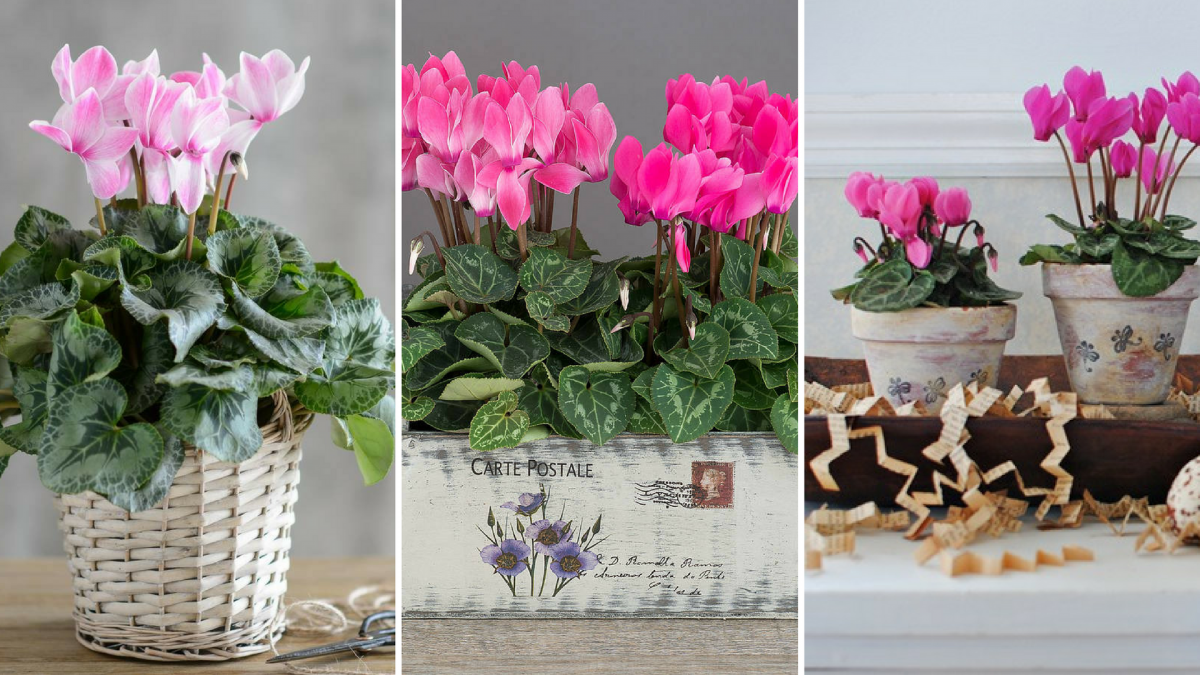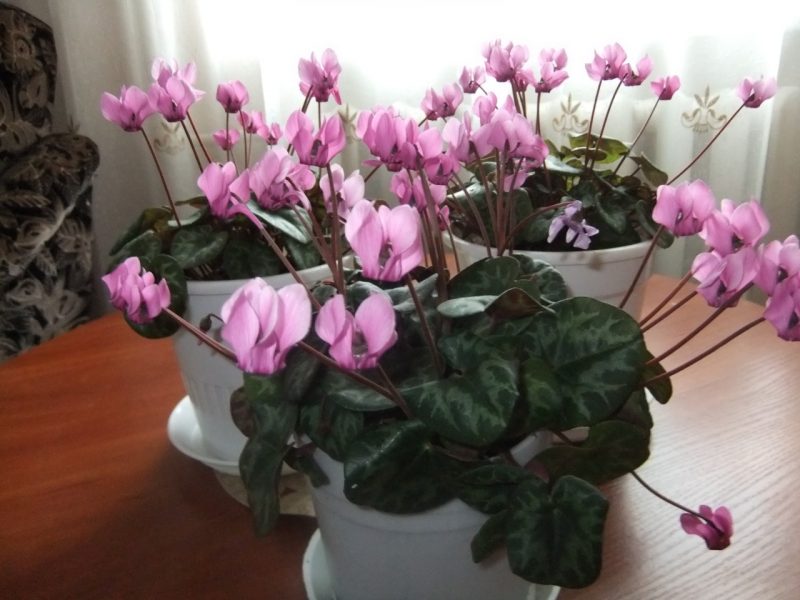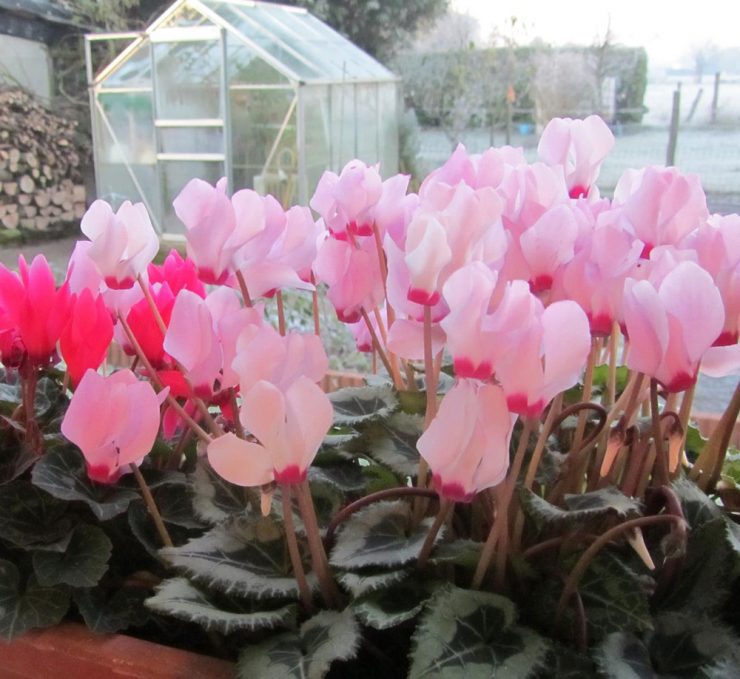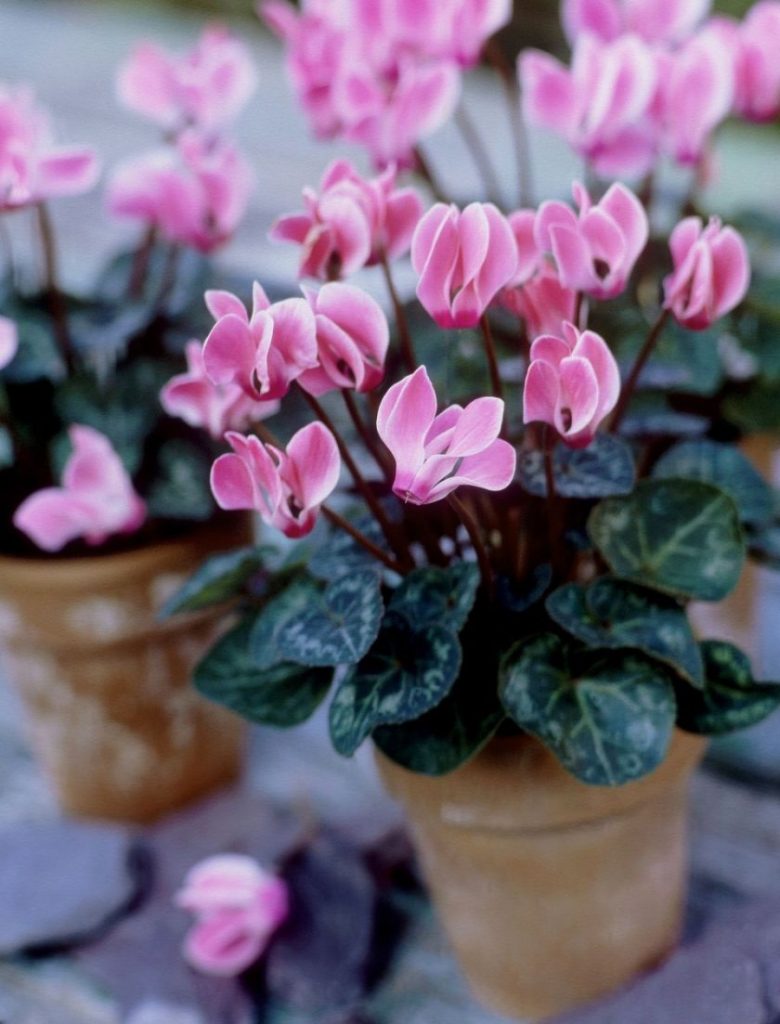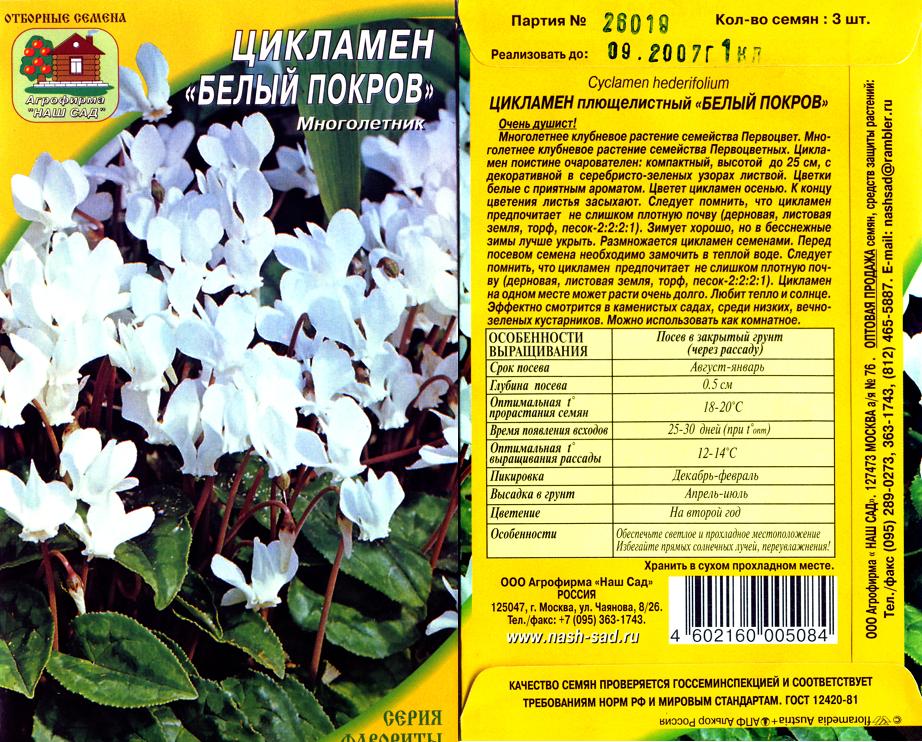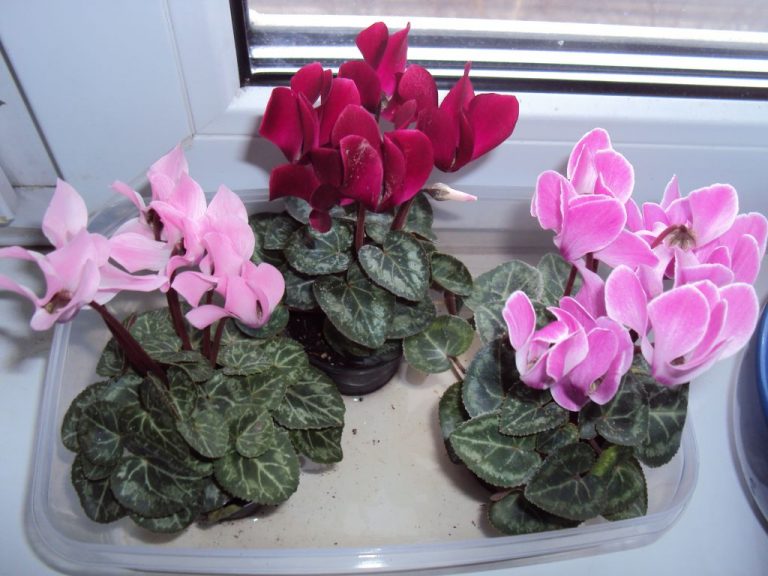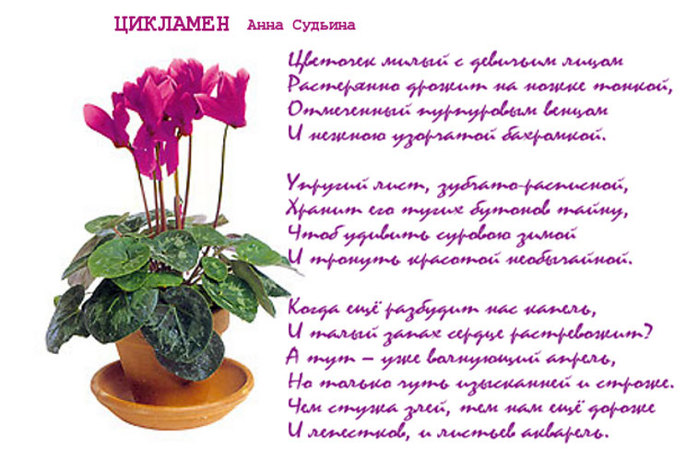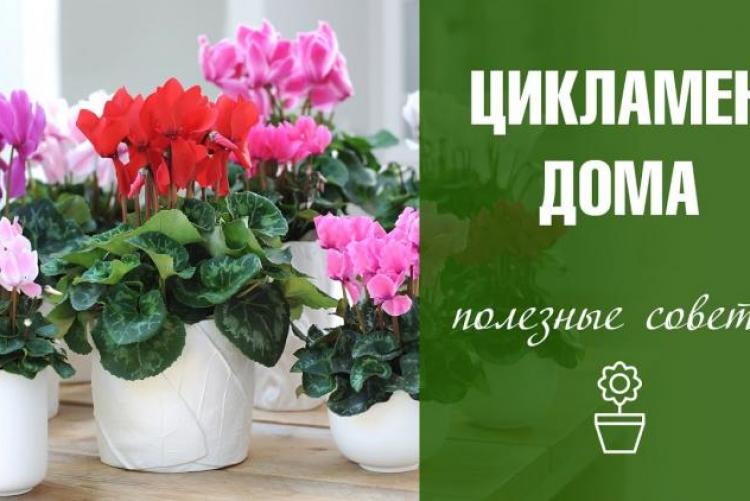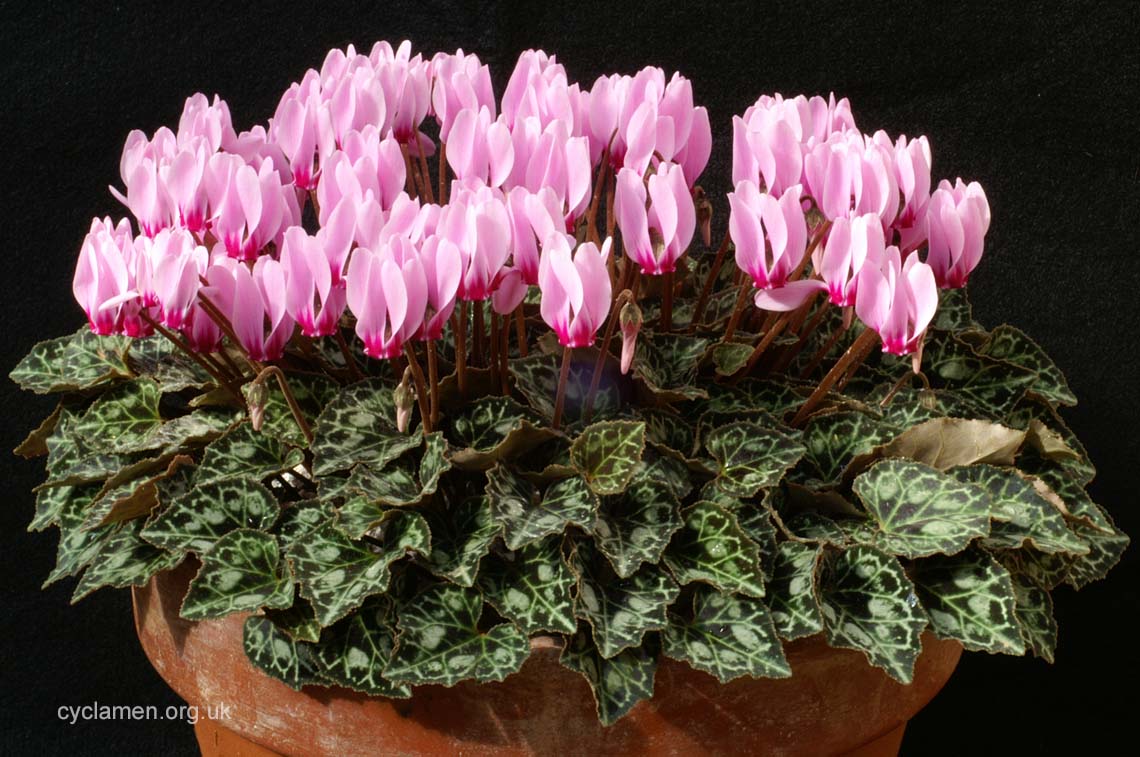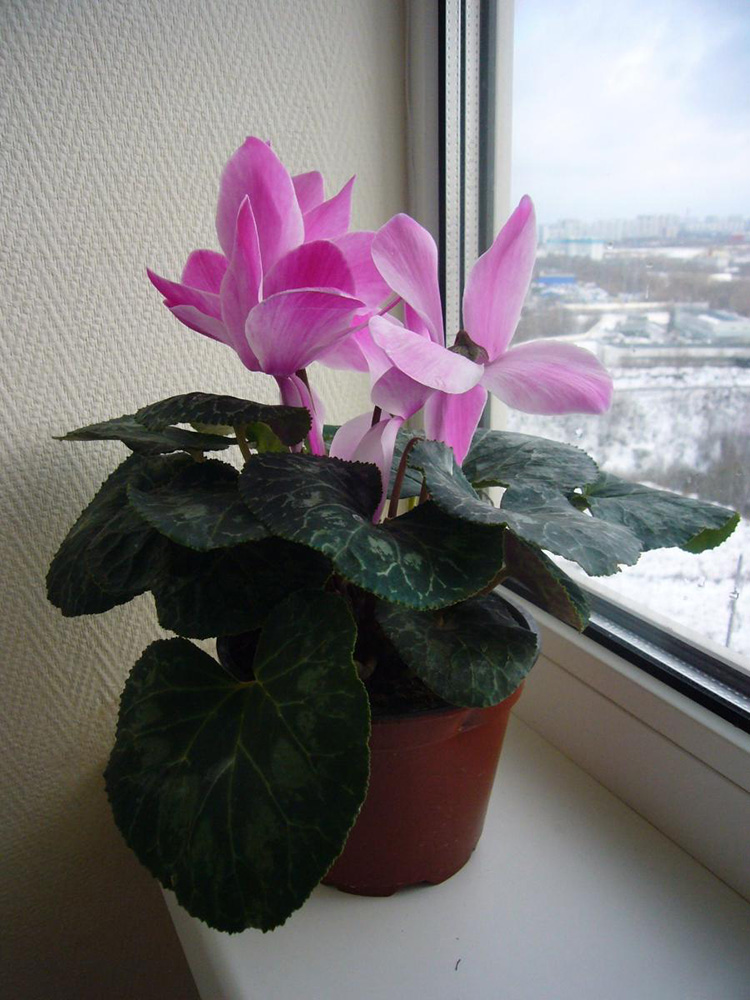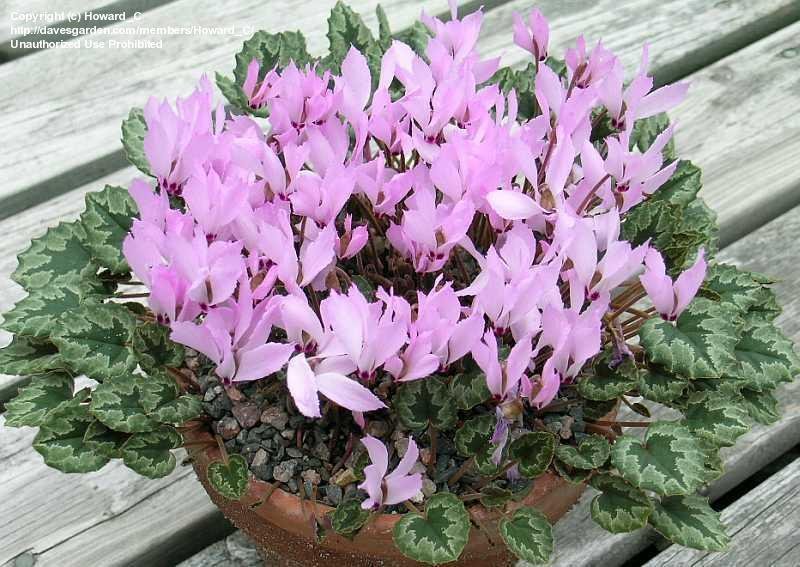How to care?
At home, caring for a flower is not very difficult, but it requires adherence to some rules.
- First of all, you need to find a suitable place for the alpine violet. The plant, although unpretentious, loves diffused light and well-ventilated rooms. Drafts are contraindicated in the flower.
- Temperature conditions are very important. It belongs to cold-loving plants, therefore it does not tolerate high temperatures. An alpine violet feels comfortable at temperatures ranging from + 14C to + 16C.
- If in the summer it is not possible to maintain the temperature optimal for growth, then the plant can be transferred to the basement. However, there must be sufficient lighting in the room. If this is not possible, then the flower can be left in a room where the air temperature should not exceed + 25C.
- In winter, when heaters and central heating radiators are turned on in the room, it is recommended to place the cyclamens away from heat sources. In this case, you need to monitor the level of humidity in the room, and water the plant in a timely manner.
- Too low room temperatures and excessive watering can lead to rotting, and then to the death of the flower.
How to water properly?
 Alpine violet is a moisture-loving plant that needs to be watered promptly, abundantly and regularly at home.
Alpine violet is a moisture-loving plant that needs to be watered promptly, abundantly and regularly at home.
At any time during the life of a flower, watering requires accuracy. It is recommended to water cyclamen through a sump, since water ingress on the stems, peduncles or tuber provokes rotting. Cuttings or flowers first begin to become covered with brown spots, and then the plant dies.
Water for watering the plant should be at room temperature and be separated. Watering plants with tap water is not recommended. If the flower requires watering, and there was no settled water in the house, then you can pour it with boiled water, previously cooled to room temperature.
When caring for an alpine violet, it is necessary to ensure that the water in the pan and pot does not stagnate for a long time. After the flower is watered, and all layers of the soil are saturated with moisture, excess water must be poured from the pan.
The Persian tuber rises above the soil, so the plant can be watered in the usual way.
Top dressing
Twice a month, during the period of active growth of leaves and during flowering, the alpine violet should be fed.
It is recommended to feed at home during watering with special fertilizers for flowering plants. At the same time, nitrogen fertilizers should not be abused, an excess of which will negatively affect the quantity and quality of flowers, and lead to a strong foliage build-up.
Resting care
After the plant has faded, its leaves begin to turn yellow and fall off. This is the first sign that the flower is entering a dormant period. At this time, at home, the alpine violet requires special care.
- All dry leaves and flowers must be cut off.
- Strong leaves need to be cut closer to the root. It is not recommended to cut them off.
- It is necessary to water the plant rarely and in small doses. The soil should be slightly damp all the time.
- It is recommended to rearrange the pot in a cool shady place.
After flowering, the life of the alpine violet is supported by its tuber.
Transfer
Caring for a plant at home includes a flower transplant, which is usually done during the summer. In this case, you must follow some rules:
- after transplanting, the upper third of the plant tuber should remain above the ground;
- the transplant is carried out in a pot, which should be 2-2.5 cm larger than the previous one;
- the soil can be prepared independently by taking for this leafy soil, river sand, humus and peat in proportions of 3: 1: 1: 1;
- before planting on the bottom of the pot, you must first pour a layer of expanded clay, then add the prepared soil, on which to place the plant and sprinkle it on the sides with an earthen mixture;
- watering the plant can be started only 10-12 days after transplanting;
- in early September, when young leaves begin to form, the flower must be rearranged in a cool but sunny place.
What needs to be done after germination
The timing of the appearance of the first shoots depends on the variety of the selected cyclamen and can range from 1 month to six months. In the future, seedlings of any variety are characterized by slow growth, which is associated with the growth of tubers. This process can take about 3 months.
It is important during the period of active growth of seedlings to regularly spray the soil in the pot and air the planting
A sprout with a pair of leaves should form from weak petal loops. When he gets stronger, fully open, it is time to dive. A young crop needs moisture and coolness, so do not forget about frequent watering and ventilation. In six months, feeding the seedling with any fertilizers for flowering crops will become relevant.
Did you know? Bioenergetics believe that cyclamens feed on negative energy, and in return give a positive charge. That is why they are advised to grow in every home..
Suitable conditions
The flower will please its owner with the flowering only when certain conditions are created
It is important to exclude excessive dryness of the air, to provide a cool temperature and simple maintenance measures. Plants of this family go dormant for several months, but flowering can be repeated up to several times a year.
The soil

Loose soil saturated with organic matter is suitable
The soil for cyclamen can be bought ready-made or made yourself. The best option is a combination of humus, sand, peat and leafy earth. The ingredients must be mixed in equal proportions. The prepared soil should be a breathable coarse peat substrate
It is important to create sufficient aeration of the plant root system.
Illumination
Cyclamens do not like excessive illumination (lighting should be bright, but diffuse). Window sills located on the east or west side are considered ideal conditions for them. Direct sunlight can cause leaves to turn yellow.

Yellowed leaves must be removed by carefully pulling them out from the tuber itself.
The plant is prone to burns. Lack of light can cause poor or no flowering.
Temperature
Temperature conditions play an important role
Particular attention should be paid to the place of purchase of the plant. If it was grown in a greenhouse, then at home it is necessary to repeat the ambient temperature as much as possible.
The accustoming of a flower to new conditions must be carried out in stages. Cyclamen loves coolness. In the cold season, the optimal temperature regime for it should not exceed 10-12 degrees, in the summer - 20 degrees.
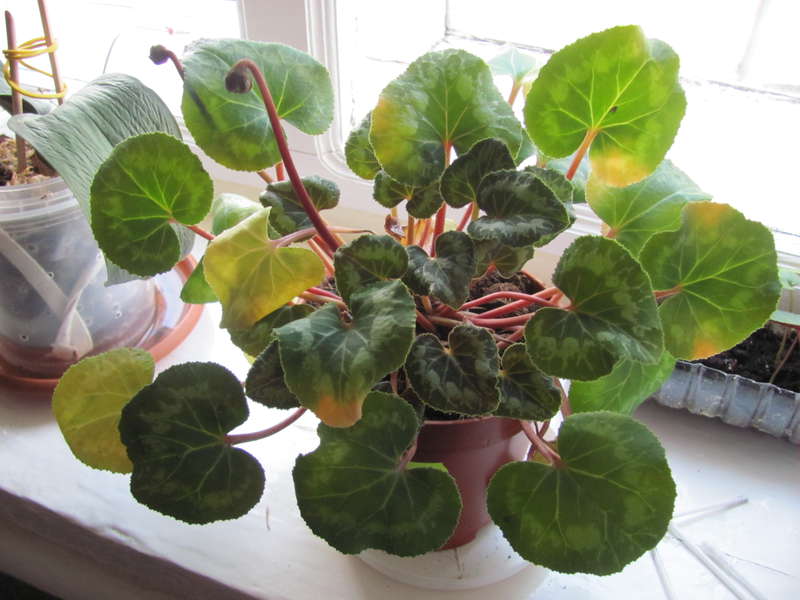
Too high temperature will provoke leaf shedding and lack of flowering
Humidity
For cyclamen, increased moisture levels are required. During the period of plant growth, its leaves must be regularly sprayed. During flowering, such a procedure is prohibited. You can humidify the air using water mist (spray it next to the cyclamen) or a tray with wet pebbles
It is important to exclude the effect of heating sources on the plant.

In winter, cover the batteries with a damp cloth.
Description of the plant
The flower is one of the representatives of the Mirsin family. Although some scholars classify him as a Primrose.Cyclamen is represented by corms with egg-shaped basal leaf plates. The color is dark green. Leaves develop on long petioles (about 30 cm). Their decorative effect is enhanced by a pattern of silvery weaves. The inflorescences are also original. They are pointed and curved back, the petals are framed along the edge.
Beneficial features
In addition to decorative qualities, the culture also has medicinal ones. The juice of the cyclamen flower tubers has anti-inflammatory and antimicrobial properties. This makes it possible to use it for sinusitis, frontal sinusitis, sinusitis and other diseases of the nasopharynx. In alternative medicine, juice, which contains alkaloids, has found application in the preparation of rubbing. The latter help relieve pain in rheumatism, gout. Cyclamen-based products help fight disorders of the cardiovascular system.
Species diversity
In the natural environment, cyclamen is represented by 20 species. However, only a few are common in culture. Popular:
- Cyclamen European, also known as Alpine violet - a typical species with medium-sized leaves blooms with fragrant pink-lilac inflorescences. On its basis, breeders bred varieties with a white, carmine color. Of all the species, the alpine violet is the most tolerant of home conditions.
- Persian has been in culture since 1731. It is appreciated for the originality of the inflorescences, which, having blossomed, seem to be turned inside out and grow petals down,
- Pontic is an evergreen flowering plant. Its peculiarity is the flowers rising high above the foliage on "naked" arrows.
- African - the species blooms very profusely. He has the largest tuber among other representatives - up to 14 cm in diameter.
Flowering cyclamen

The start of the phase is influenced by the variety and the growing conditions. Flowering often occurs in the second half of autumn. If the required microclimate is created for the flower, flowering lasts 2-3 months. The color range of inflorescences is very wide. There are varieties with snow-white flowers, scarlet, burgundy and even purple, all kinds of tones of pink.
For your information, Cyclomenia is a poisonous plant. If children live in the apartment, it is better to refuse it.
Growing conditions
In order for the cyclamen to delight with flowering regularly, a certain microclimate is created for the plant, similar to the natural one. The organization of a comfortable temperature regime is one of the more time-consuming tasks when cultivating culture in an apartment. In providing other requirements of cyclamen, difficulties do not arise for flower growers.
Temperature control and lighting

The exotic needs an abundance of diffused light. But it is impossible to place the pot on the windowsill of the south window, since the direct rays of the midday sun will leave burns on tender shoots. Since cyclamen loves fresh air, the room where it grows is systematically ventilated. The plant does not tolerate heat well. The comfortable temperature for him ranges from 10-12 ° C, and in winter it is better to lower it to 6 ° C. In houses with central heating, it is not easy to fulfill the condition.
Humidity
Cyclamen does not need frequent spraying. It tolerates well the level of humidity that exists in apartments. However, with excessively dry air, water procedures are rarely carried out. During the flowering period, large drops on the petals can harm the decorativeness of the plant, provoking the development of rot. At this time, a stationary air humidifier is used or a misty cloud is created over the flower using a fine spray.
Soil and pot
Loose soil is suitable for the plant, which passes air well to the roots, as well as water. The pH reaction of cyclamen prefers slightly alkaline, although it grows well with neutral or slightly acidic, but immunity is slightly weaker. The optimal composition of the soil: leafy soil, sand, sod, needles. The components are taken in a ratio of 4: 1: 2: ½. The pot should not be too spacious: this leads to acidification of the substrate.When choosing a container, the material is not important. But the drainage holes should be.
Proper care of cyclamen at home
The appearance of cyclamen directly depends on the degree of plant care. If the pot is in a draft zone, too little or too much light falls on the leaves, there is not enough air humidity or other requirements are violated, then there is a danger of the death of the flower. Subject to the care algorithm, the plant will bloom fully and leave the dormant period in a timely manner.
Watering

It is recommended to irrigate through the pallet. If you do this from above, then the stream of water should be directed closer to the edge of the pot so as not to soak the tuber.
For cyclamens, frequent, but moderate watering is recommended (the water should be at room temperature and previously settled). Before flowering, it is necessary to water not only the soil, but also to ensure the moistening of the pallet. Excess water is necessarily eliminated. With the appearance of peduncles, the amount of moisture decreases, but the soil must always be moist. If the plant has lost all the leaves and entered a state of dormancy, then the amount of watering must be reduced (but excessive dryness of the soil must not be allowed).
Top dressing
Almost any fertilizer with mineral components and high potassium content is suitable for feeding. The procedure is recommended to be carried out approximately once every two weeks.
It is important to observe the dosage of dressings. Overdose can cause no flowering
No fertilizer is used while the plant is in bloom. Before feeding, it is necessary to moisten the soil (to exclude the accumulation of salts in the ground).
Pruning
Pruning cyclamen is carried out as needed (when the leaves and flowers dry up). If dry or decayed roots are revealed during transplantation, they must also be removed. It is strictly forbidden to prune the flowering cyclamen (the inflorescences will fall off ahead of time). It is better to correct the shape of the plant in the autumn.
Features of care during flowering and after
When flowering, the rules for caring for cyclamen change. You cannot spray the flowers (watering is carried out only through the pallet). Dried inflorescences must be removed by twisting. It is impossible to leave dry petals (if moisture gets on them, the process of decay will begin, which will affect the healthy parts of the plant). After flowering, care resumes (feeding, temperature, watering, etc.).
Features of winter care
In winter, special care and attention to the plant is required. The use of dressings and fertilizers is a prerequisite for the prevention of fungal diseases.
Dry leaves and flowers must be removed immediately. Requirements for lighting, watering and air humidity remain traditional.
Resting state
From May to June, cyclamens go into a dormant state (the leaves completely dry up and fall off). During this period, the pot should be placed in a cool place and the amount of watering should be reduced (it is necessary to moisten the soil as the top layer dries). The first leaves appear around the end of July. An increase in temperature can provoke the death of cyclamen.
Reproduction
Cyclamens, whose age has not reached seven years, are suitable for reproduction. There are several options for such a procedure - with the help of seeds, tubers, rosettes and children. In the second case, difficulties may arise. When using tubers for propagation, they must be cut into pieces while preserving the root and bud. The workpiece must be dried and planted in the traditional way. It is difficult to reproduce cyclamen with the help of sockets and children. The workpieces must first be held in the greenhouse (film and pot construction). After a few days, you can create normal conditions, but with abundant watering.
Home cultivars
There are several suitable varieties for home growing:
Persian is the most popular. It is larger than all other species. Bloom from December to May.
European or purple cyclamen - the care of which is slightly different, since it blooms in the fall. Does not shed leaves during winter dormancy.
Ivy. In warm countries, it can grow in open ground, but for the middle zone it is not frost-resistant enough.
Kosky. It is found wild in Bulgaria, Turkey, and the Middle East.
African. It is characterized by the fact that the peduncles appear before the leaves.
There are subspecies within each species. For example, among the European varieties there are varieties of Green Ice, Silver, Album.
It has small pink flowers, up to 2 cm in diameter. The leaves grow from the tuber, have a silvery pattern.

The flowers are pink with lilac stripes. Leaves are glossy with streaks.

Miniature form with white peduncles and dark green leaves with silvery streaks.

Lake Garda
A plant with lighter leaves and a dark outline. The flowers are pink.
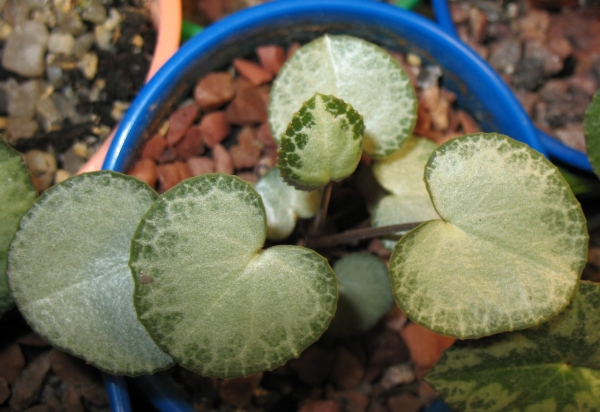
European cyclamen is easier to care for, propagates more easily and does not shed leaves, which makes the flower attractive throughout the year.
Cyclamen transplant
Dryad is often sold in pots with peat soil, which is more suitable for transporting flowers, rather than for growing them for a long time. Therefore, after the purchase, the plant needs to be transplanted, but not immediately, but after flowering and rest. How to do it correctly:
- Remove the flower from the pot, gently shake the tuber and roots from the peat. Remove rotten cuttings (if any), sprinkle the cut with crushed activated carbon.
- Pour expanded clay (pebbles, gravel) and a layer of disinfected earth on the bottom of the container with drainage holes.
- Place the root system in the center of the pot, keeping the plant hanging. Pour in the soil mixture, gently straightening the roots. Do not seal.
- Water the flower, let the moisture soak in, and repeat the watering. Top up the soil mixture. When planting a Persian cyclamen, cover the tuber with soil 2/3, cover the bulb of a European perennial with soil completely.
Young plants (up to 5 years old) are recommended to be replanted annually, adults - 1 time in 2-3 years. The procedure is carried out after the resting phase, until the flower has started to grow. The optimal time for transplanting the Persian cyclamen is autumn, the European one is spring. During the process, the dryad is transferred from one container to another along with an old clod of earth.
Can I transplant during flowering
When transplanting, cyclamen experiences stress, no matter what fertile nutrient substrate you place it in. For this reason, disturbing the plant during flowering is not recommended. Otherwise, the process will lead to the death of flower stalks and reduce the ability of the perennial to form buds in the future. The ideal time for a transplant is to wake up after a resting phase.
Soil for cyclamen and pot selection
When replanting the duckweed, a substrate for bulbous plants (Florin, Tulip) or a soil mixture prepared from leafy soil, river sand, humus and peat is used. The ratio of the components is 3: 1: 1: 1. Before transplanting, the soil is calcined in the oven, poured with boiling water or a slightly pink solution of potassium permanganate. The pot is chosen from plastic or ceramic, with drainage holes. Its diameter should be 2-3 cm wider than the flower tuber.
How to grow by seeds
If you want to have a beautiful and fragrant-smelling flower at home, it is grown from seeds.
Selection or collection of planting material
There are two ways to obtain seed for growing alpine violets on a windowsill:
- Purchase of seeds in a florist shop. Such material from well-known manufacturers has an increased germination rate (about 80%).
- Self-collection from plants. To do this, first, artificial pollination is carried out. With a brush, gently move the pollen from one flower to another. To increase the likelihood of pollination, do this several times. The best time for the procedure is early in the morning.After the seed pods appear on the flower, they are plucked without waiting for cracking. They are wrapped in dry napkins and are waiting for the capsule to crack and seed material to appear.
The plant loves a cool microclimate, and in such conditions, seed germination will take place much faster.

Tank and soil preparation
For sowing the material, a light substrate purchased at the store is preferable; it should consist of vermiculite, leafy earth and peat. If desired, it is prepared at home, in a ratio of 1: 1: 1. At the bottom of a small plastic container, a drainage layer of foam or expanded clay must be laid. Also, the pot should have holes for the outflow of excess liquid.
Landing scheme
Before planting alpine violet seeds, they are soaked for three days in cold water, which is changed every day. The seed container is kept in a cool place. Next, cyclamen seeds are laid out on the surface of the prepared substrate and sprinkled on top with a layer of soil no more than 2 cm.A distance of 2-3 cm is maintained between the seeds themselves.After that, the container is covered with plastic wrap and taken out into a room where the temperature does not exceed 20 degrees.

How to transplant after purchase
As a rule, alpine violets are bought during the flowering period, and not dormant, when there is only a bulb in the ground. At this time, it is impossible to transplant cyclamen. They wait until the end of the flowering period and only after that they start the procedure. This is recommended only when the plant is cramped in the old pot. Transplantation is not performed without special need.
Possible problems
When growing alpine violets in a home, sometimes growers are faced with problems, these are diseases and pests that affect cyclamen.
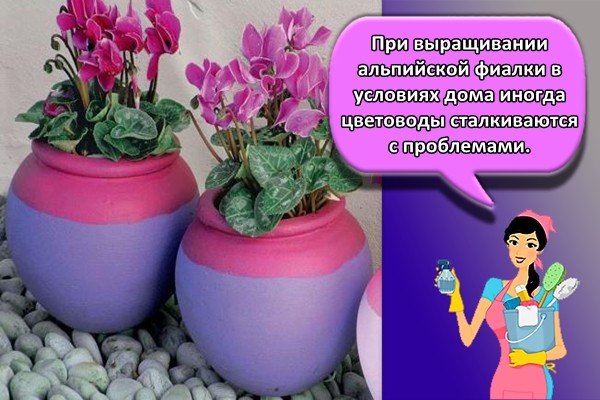
Yellowing of leaves
This is a natural process. The leaves turn yellow and wither as the alpine violet prepares for its dormant period. However, this sometimes signals that the plant is over-hydrated when its roots begin to rot.
Wet rot
The nature of this disease is bacterial. Signs of damage include a sharp wilting of foliage and an arising smell of rot. Unfortunately, in this case it will not be possible to save the alpine violet. The flower is destroyed immediately so that it does not infect other plants.
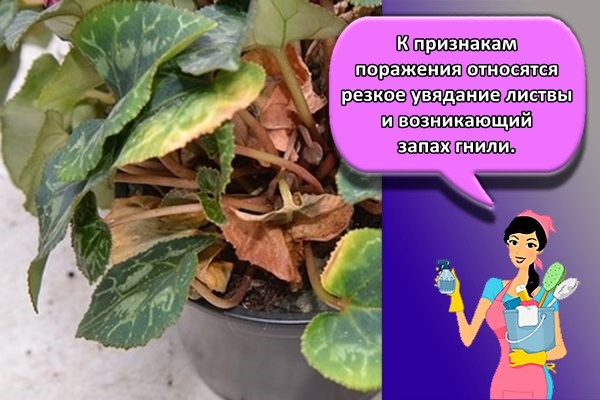
Flying over the foliage
Cyclamen leaf plates fall off when there is insufficient air humidity and high temperature indicators. It is necessary to adjust these parameters to the required ones.
Gray rot
If a silvery coating appears on the leaf plates, this is a sign that the cyclamen has been affected by gray rot. The cause of this pathology is a fungus that develops rapidly when the soil is overmoistened and the room in which the plant is kept is too cold. The affected parts of the flower are carefully removed with a sharp disinfected knife, and all sections are treated with any fungicidal preparation.
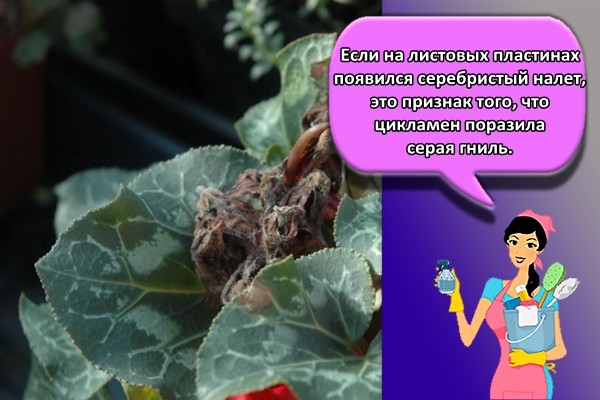
Cyclamen mite
The main problem is that the pest is not easy to detect in the early stages of infection due to its translucent appearance. It attacks cyclamens by sucking out cell sap. The cause of the appearance of the pest is the increased humidity and high temperatures. In the first stages, they get rid of it by treating the plants with hot water. If there are many pests, acaricidal preparations are used - "Sunmayt", "Omayta", "Neoron". Cyclamen processing is carried out three times. It is advisable to use a different remedy each time.
Grape weevil
These pests are omnivorous, they feed on seeds, roots, and plant buds. To combat them, any systemic insecticide is used.
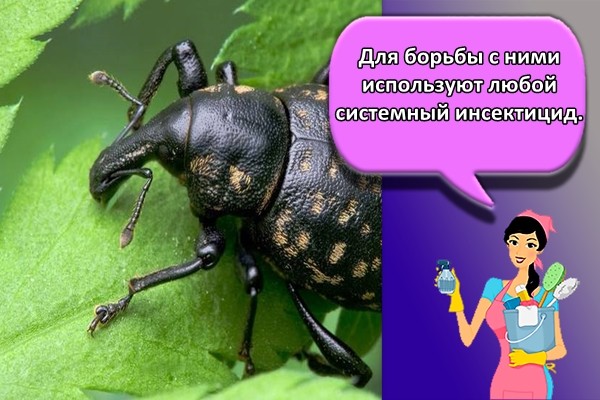
Shield
One of the most dangerous pests of alpine violets, as it absolutely does not lend itself to the effects of chemicals. It is possible to get rid of the scabbard only mechanically.Wipe the affected areas with a cotton swab dipped in an alcohol solution, and then manually tear the insect off the cyclamen leaves.
Fusarium
It is fungal in nature. The leaves of the alpine violet first turn yellow on one side, subsequently the fusarium wilting spreads to the entire leaf plate, and it dies off. The affected parts of the cyclamen are removed and the sections are treated with any fungicidal preparation, for example, "Fundazol".
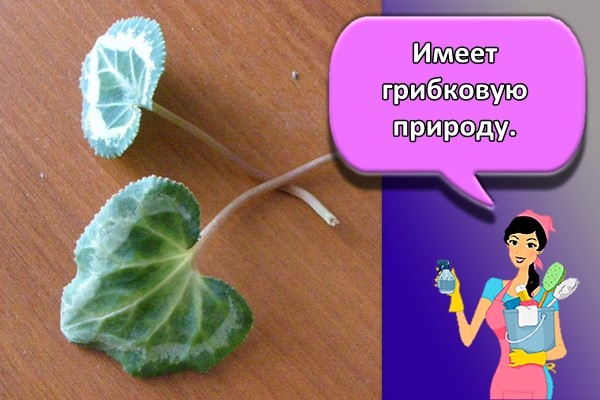
Aphid
The deformed and twisted leaves are the result of the influence of aphid colonies, which drinks all the juices from the plant. To destroy the pest, a solution of household or green soap is used, as well as the chemical preparation Fitoverm.
Thrips
The appearance of white dots on the foliage, gradually merging into silvery spots, indicates the presence of thrips on the plant. It is possible to destroy the pest only at an early stage of infection. To do this, use chemicals - "Aktara" or "Fitoverm".

Description and types
The genus Cyclamen, either Dryakva or Alpine violet from the Myrsinaceae family, sometimes attributed to the Primulaceae family, includes about twenty species.
Species of this genus are perennial herbaceous plants, common in the Mediterranean; from Spain in the west to Iran in the east, and of course in Northeast Africa, including Somalia.
Basal dark emerald leathery heart-shaped leaves are located on petioles up to thirty centimeters long, and also have a decorative smoky-silver pattern. Flowers of this species are extremely original: pointed, curved back, sometimes fringed petals create the feeling as if a flock of outlandish butterflies are circling over the flower.
The color palette is exceptionally wide: hybrids with white flowers have been bred, the whole gamut of pinkish shades to dark red, red, purple. Flowering lasts quite a long time, up to 3.5 months. It all depends on the variety and home conditions, flowering can begin from the 2nd half of October and continue until the end of March.
Quite often, this type of flowers is assessed as capricious, as well as complex plants in culture. In essence, cyclamen is undemanding, and the few requirements that it makes in culture can be extremely easy to satisfy.
Plant varieties
The genus of cyclamen in our nature has about twenty species, among which there are those that are great for home keeping. Similar species, such as Persian and European, are more common among domestic breeds. Often they also come across their hybrid flower, as well as a cyclamen mix that combines the qualities of both plants.
European potted cyclamen is a regular guest at home collections of flower connoisseurs. In another way, it can be called alpine or alpine violet. Many professional flower growers consider it a true gem among the variety of garden and indoor species. Such a common outlandish plant can be purchased at any time of the year.
It is characterized by the presence of the widest range of shades, as well as graceful simple or double flowers. The color of flowers, similar to a butterfly, can change from white or pale pink to juicy red or purple. Young plants can bloom almost without interruption.
Over time, the flower loses this amazing ability, however, it does not cease to delight the owner with a long flowering period. It can grow up to fifteen years old, producing up to seventy flowers from year to year.
The Persian species is distinguished by greater legibility and even a certain capriciousness in breeding and grooming. This type is less popular. In appearance, these two species are extremely similar. They are recognized by the following number of distinctive features:
- European cyclamen has smaller leaves as well as flowers.
- The fringed Persian species rests from early spring to the first month of autumn. At this very time, he needs the creation of special conditions and scrupulous care. The European type at this time is not so capricious. He doesn't even drop the leaves.
- On the reverse side of the Persian look, the leaves have a burgundy or emerald color.
- A dormant period is an indispensable condition for the Persian plant species; the European species does not need it.
Being the owner of any of the species of such a beautiful plant, the florist needs to know what the care of the cyclamen should be like at the end of flowering; in a different development of events, the plant will die very quickly.


